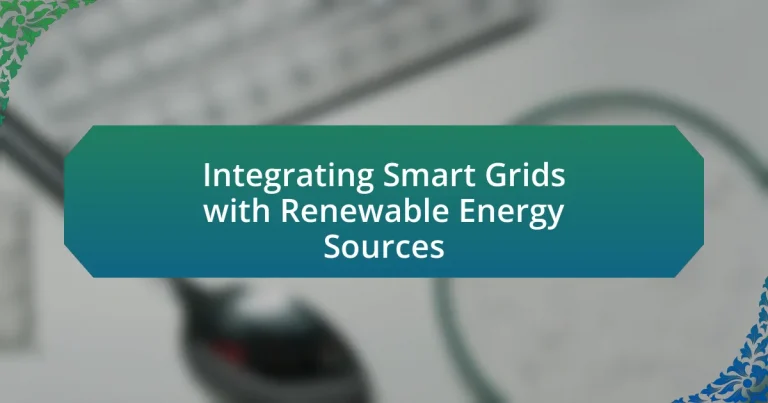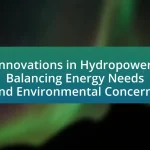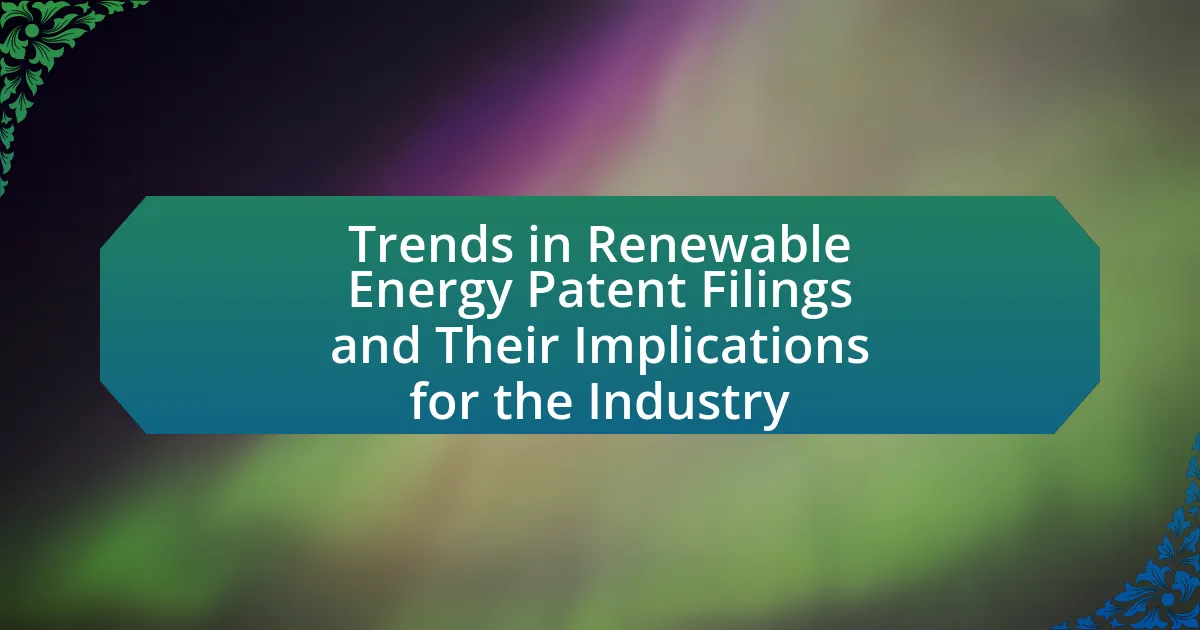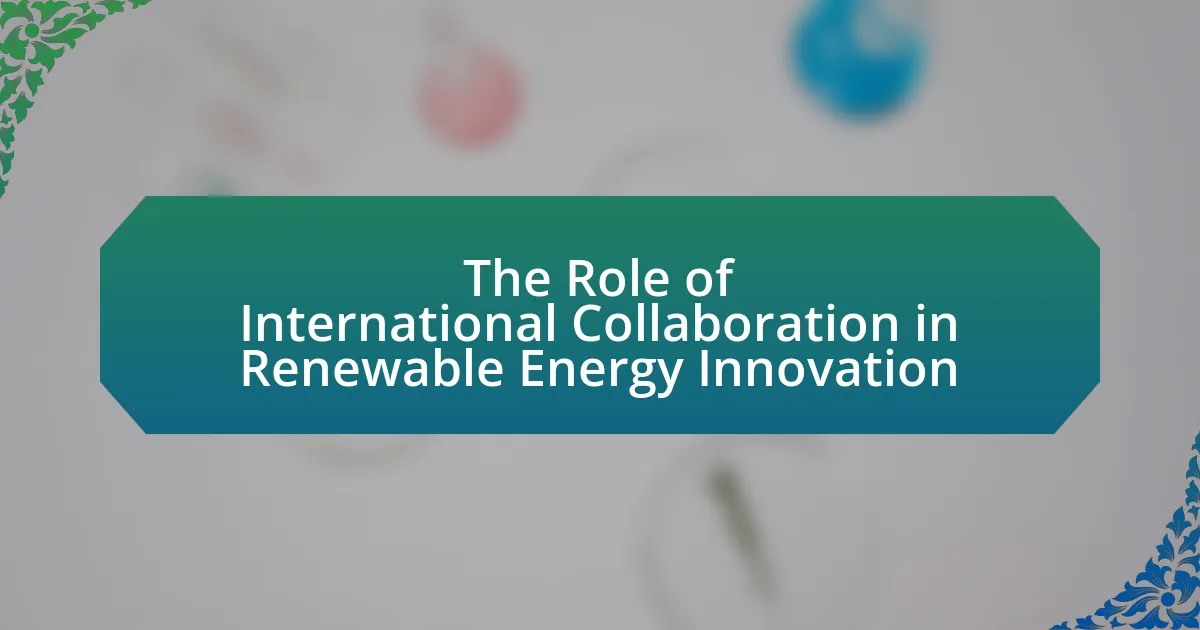Integrating smart grids with renewable energy sources involves the application of advanced technologies to improve the efficiency and reliability of electricity distribution from renewable sources such as solar and wind. This integration facilitates real-time monitoring and management of energy flows, enhances demand response, and optimizes energy storage solutions. Key technologies essential for this integration include advanced metering infrastructure, demand response systems, and energy management systems. The article also addresses the environmental benefits, energy security implications, and challenges faced in this integration process, including technical barriers and regulatory issues. Furthermore, it explores future trends and practical steps stakeholders can take to enhance the integration of smart grids with renewable energy sources.
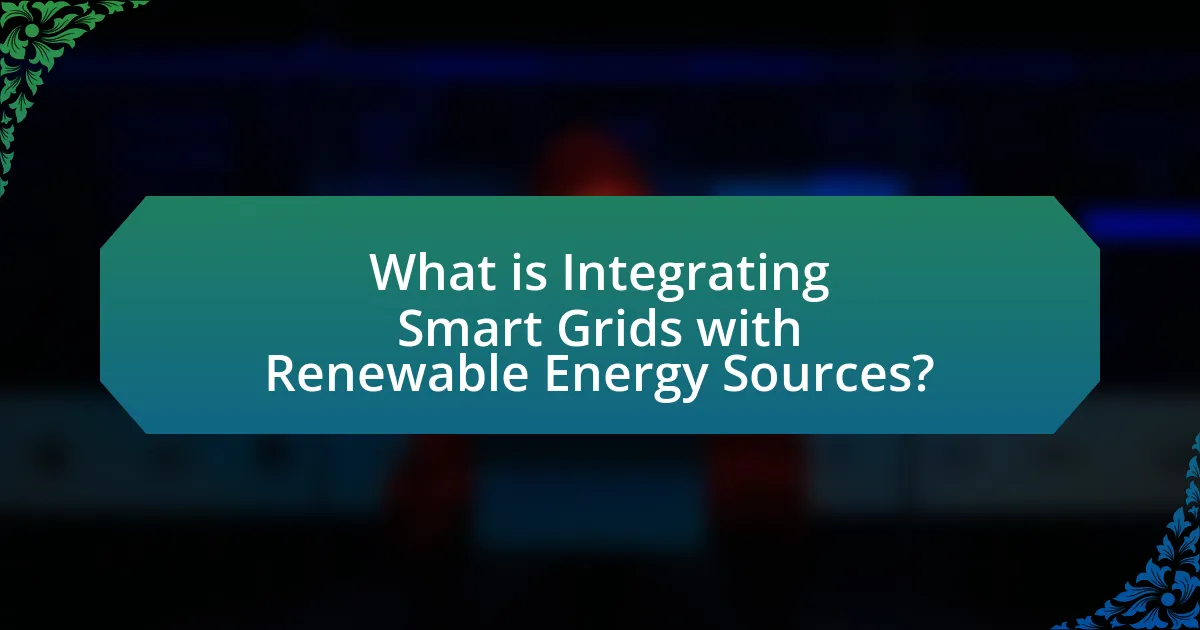
What is Integrating Smart Grids with Renewable Energy Sources?
Integrating smart grids with renewable energy sources involves the use of advanced technology to enhance the efficiency and reliability of electricity distribution from renewable sources like solar and wind. This integration allows for real-time monitoring and management of energy flow, enabling better demand response and energy storage solutions. According to the U.S. Department of Energy, smart grids can significantly reduce energy losses and improve the integration of renewable energy, which accounted for approximately 20% of the total electricity generation in the U.S. in 2020. This synergy between smart grids and renewable energy sources is essential for achieving a sustainable energy future and reducing greenhouse gas emissions.
How do smart grids function in the context of renewable energy?
Smart grids function by utilizing advanced communication and automation technologies to enhance the integration of renewable energy sources into the electricity grid. They enable real-time monitoring and management of energy flows, allowing for efficient distribution and consumption of electricity generated from renewable sources like solar and wind. For instance, smart grids can balance supply and demand dynamically, accommodating the variable nature of renewable energy production. This capability is supported by data analytics and smart meters, which provide detailed insights into energy usage patterns and grid performance, thereby optimizing the overall energy system.
What technologies are essential for smart grid integration?
Essential technologies for smart grid integration include advanced metering infrastructure (AMI), demand response systems, energy management systems (EMS), and distributed energy resource management systems (DERMS). AMI enables real-time data collection and communication between utilities and consumers, facilitating efficient energy usage. Demand response systems allow for the adjustment of consumer energy usage during peak periods, enhancing grid reliability. EMS optimizes energy production and consumption, while DERMS manage the integration of renewable energy sources, ensuring stability and efficiency in the grid. These technologies collectively support the transition to a more resilient and sustainable energy system.
How do smart grids enhance energy distribution from renewable sources?
Smart grids enhance energy distribution from renewable sources by utilizing advanced communication and automation technologies to optimize the flow of electricity. These systems enable real-time monitoring and management of energy supply and demand, allowing for better integration of variable renewable energy sources like solar and wind. For instance, smart grids can adjust energy distribution based on real-time data, ensuring that excess energy generated during peak production times is efficiently stored or redirected to meet demand, thereby reducing waste. According to the U.S. Department of Energy, smart grid technologies can increase the efficiency of energy distribution by up to 30%, significantly improving the reliability and sustainability of renewable energy integration.
Why is the integration of smart grids and renewable energy important?
The integration of smart grids and renewable energy is important because it enhances energy efficiency and reliability while facilitating the transition to a sustainable energy system. Smart grids utilize advanced communication and control technologies to optimize electricity distribution, enabling better management of variable renewable energy sources like solar and wind. According to the U.S. Department of Energy, smart grid technologies can reduce energy consumption by up to 30% and significantly lower greenhouse gas emissions, thereby supporting climate goals. This integration also improves grid resilience, allowing for quicker recovery from outages and better handling of peak demand, which is crucial as renewable energy sources become more prevalent in the energy mix.
What environmental benefits arise from this integration?
Integrating smart grids with renewable energy sources significantly reduces greenhouse gas emissions. This integration allows for more efficient energy distribution and consumption, leading to a decrease in reliance on fossil fuels. For instance, according to the International Renewable Energy Agency, transitioning to renewable energy can cut global carbon dioxide emissions by up to 70% by 2050. Additionally, smart grids enhance the integration of diverse renewable sources, such as solar and wind, which further minimizes environmental impact by promoting cleaner energy generation.
How does this integration contribute to energy security?
The integration of smart grids with renewable energy sources enhances energy security by enabling a more resilient and flexible energy infrastructure. This integration allows for real-time monitoring and management of energy supply and demand, which reduces the risk of outages and improves response times during disruptions. For instance, according to the U.S. Department of Energy, smart grid technologies can reduce the duration of power outages by up to 30%, thereby increasing reliability. Furthermore, the incorporation of diverse renewable energy sources, such as solar and wind, decreases dependence on fossil fuels, mitigating risks associated with fuel supply disruptions and price volatility. This diversification strengthens the overall energy supply chain, contributing to a more secure energy future.
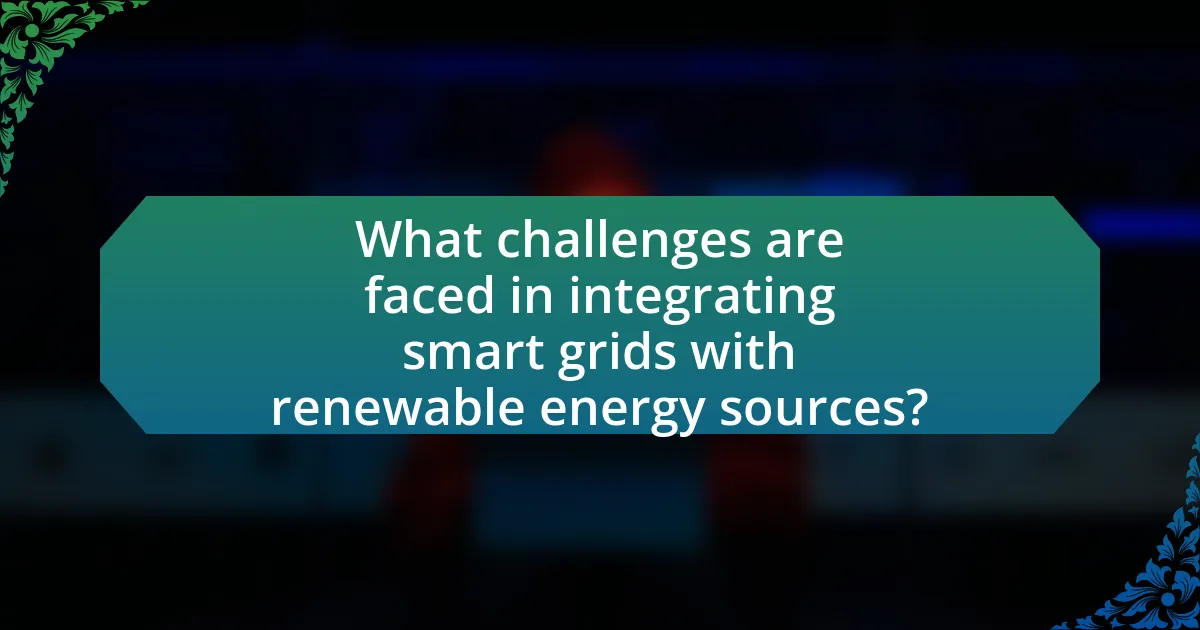
What challenges are faced in integrating smart grids with renewable energy sources?
Integrating smart grids with renewable energy sources faces several challenges, primarily related to variability, infrastructure, and regulatory issues. The variability of renewable energy, such as solar and wind, leads to fluctuations in power generation, complicating grid stability and reliability. Infrastructure challenges arise from the need for advanced technology and upgrades to existing grid systems to accommodate distributed energy resources. Additionally, regulatory frameworks often lag behind technological advancements, creating barriers to implementation and integration. These challenges necessitate coordinated efforts among stakeholders to develop solutions that enhance grid resilience and efficiency.
What technical barriers exist in the integration process?
Technical barriers in the integration process of smart grids with renewable energy sources include interoperability issues, data management challenges, and infrastructure limitations. Interoperability issues arise from the lack of standardized protocols among different technologies and systems, which complicates communication and coordination. Data management challenges stem from the vast amounts of data generated by renewable sources, requiring advanced analytics and storage solutions to ensure effective utilization. Infrastructure limitations refer to the existing grid’s inability to handle the variable and decentralized nature of renewable energy, necessitating upgrades and investments in new technologies. These barriers hinder the seamless integration of renewable energy into smart grids, impacting efficiency and reliability.
How do grid stability and reliability issues affect integration?
Grid stability and reliability issues significantly hinder the integration of renewable energy sources into smart grids. When grid stability is compromised, it can lead to fluctuations in voltage and frequency, making it challenging to maintain a consistent power supply. For instance, the variability of renewable energy sources, such as solar and wind, exacerbates these stability concerns, as their output can change rapidly due to environmental conditions. According to the National Renewable Energy Laboratory, integrating high levels of renewables requires advanced grid management techniques to ensure reliability, which can be costly and complex. Therefore, without addressing stability and reliability issues, the seamless integration of renewable energy into smart grids remains problematic.
What role do energy storage solutions play in overcoming these challenges?
Energy storage solutions are crucial for overcoming the challenges associated with integrating smart grids and renewable energy sources. They provide a means to store excess energy generated during peak production times, such as sunny or windy periods, and release it during periods of high demand or low generation. This capability helps to balance supply and demand, ensuring grid stability and reliability. For instance, according to the U.S. Department of Energy, energy storage can enhance grid resilience by providing backup power during outages and facilitating the integration of variable renewable energy sources, which accounted for 20% of U.S. electricity generation in 2020. Thus, energy storage solutions play a vital role in enabling a more flexible and responsive energy system.
What regulatory and policy challenges impact integration?
Regulatory and policy challenges impacting the integration of smart grids with renewable energy sources include inconsistent regulations, lack of standardized policies, and insufficient incentives for investment. Inconsistent regulations across different jurisdictions create barriers for energy providers, making it difficult to implement uniform smart grid technologies. The absence of standardized policies hinders interoperability between various systems and technologies, complicating integration efforts. Additionally, insufficient financial incentives for both utilities and consumers can slow down the adoption of renewable energy sources, as stakeholders may be reluctant to invest in new infrastructure without guaranteed returns. These challenges are documented in studies such as the International Energy Agency’s “Smart Grids: Key Enablers of the Energy Transition,” which highlights the need for cohesive regulatory frameworks to facilitate effective integration.
How do government incentives influence the adoption of smart grids?
Government incentives significantly accelerate the adoption of smart grids by reducing financial barriers and promoting investment in advanced technologies. These incentives, such as tax credits, grants, and subsidies, lower the initial costs for utilities and consumers, making the transition to smart grid systems more economically viable. For instance, the U.S. Department of Energy allocated over $4.5 billion in funding for smart grid projects through the American Recovery and Reinvestment Act of 2009, which led to widespread implementation and modernization of electrical infrastructure. This financial support not only encourages utilities to upgrade their systems but also fosters innovation and competition among technology providers, ultimately enhancing the integration of renewable energy sources into the grid.
What are the implications of existing energy policies on integration efforts?
Existing energy policies significantly influence integration efforts of smart grids with renewable energy sources by establishing regulatory frameworks and financial incentives that either facilitate or hinder technological adoption. For instance, policies promoting renewable energy targets, such as the European Union’s Renewable Energy Directive, encourage investments in smart grid technologies, thereby enhancing integration capabilities. Conversely, outdated regulations that favor fossil fuels can obstruct the deployment of innovative solutions necessary for effective integration, as seen in regions where legacy systems dominate. These implications underscore the critical role of adaptive energy policies in shaping the success of integration initiatives.
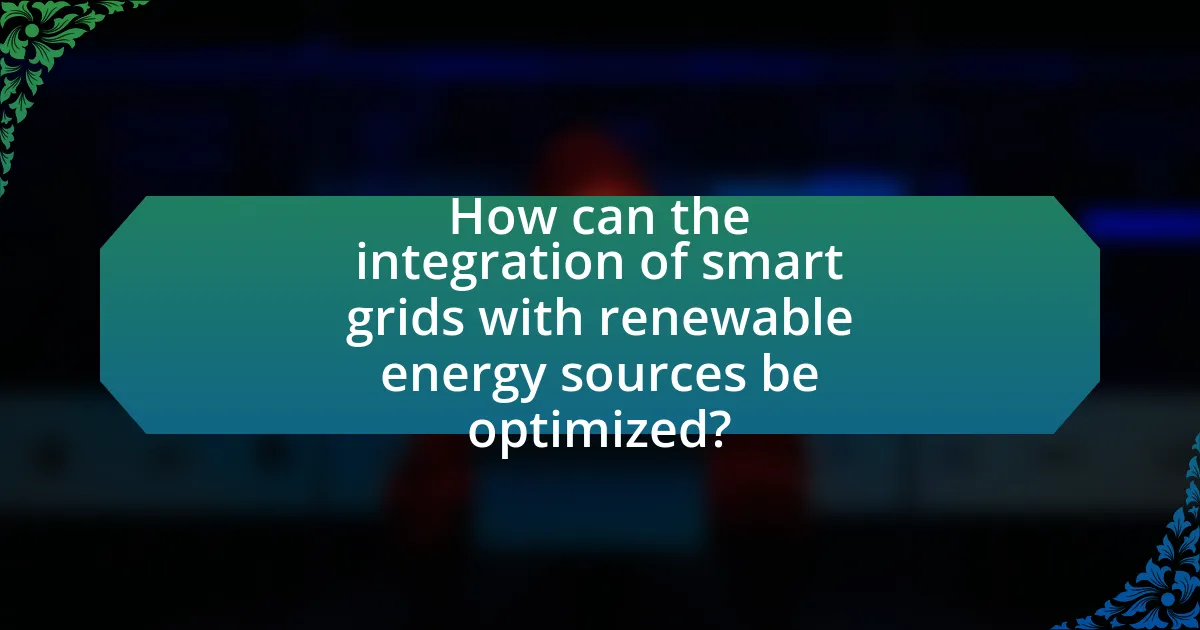
How can the integration of smart grids with renewable energy sources be optimized?
The integration of smart grids with renewable energy sources can be optimized by implementing advanced energy management systems that enhance real-time data analytics and demand response capabilities. These systems enable better forecasting of energy production from renewable sources, such as solar and wind, which are inherently variable. For instance, a study by the National Renewable Energy Laboratory found that integrating predictive analytics can increase the efficiency of renewable energy utilization by up to 30%. Additionally, deploying energy storage solutions, such as batteries, allows for the balancing of supply and demand, ensuring that excess energy generated during peak production times can be stored and used when production is low. This approach not only stabilizes the grid but also maximizes the use of renewable energy, reducing reliance on fossil fuels and lowering greenhouse gas emissions.
What best practices should be followed for successful integration?
Successful integration of smart grids with renewable energy sources requires a comprehensive approach that includes standardization, interoperability, and robust communication protocols. Standardization ensures that different technologies and systems can work together seamlessly, while interoperability allows for the integration of various renewable energy sources, such as solar and wind, into the grid. Robust communication protocols facilitate real-time data exchange, enabling better management of energy supply and demand. According to the International Energy Agency, implementing these best practices can enhance grid reliability and efficiency, ultimately leading to a more sustainable energy future.
How can data analytics improve the efficiency of smart grids?
Data analytics can improve the efficiency of smart grids by enabling real-time monitoring and optimization of energy distribution. By analyzing data from various sources, such as smart meters and sensors, utilities can identify patterns in energy consumption and generation, allowing for better demand response and load balancing. For instance, a study by the U.S. Department of Energy found that implementing data analytics in smart grids can reduce operational costs by up to 20% and enhance grid reliability. This optimization leads to a more efficient integration of renewable energy sources, as data analytics helps predict renewable generation patterns and adjust energy distribution accordingly.
What role does consumer engagement play in optimizing integration?
Consumer engagement plays a crucial role in optimizing integration by fostering active participation and feedback from users, which enhances the efficiency and effectiveness of smart grid systems. Engaged consumers are more likely to adopt energy-saving behaviors and utilize renewable energy sources, leading to a more balanced energy demand and supply. Studies indicate that when consumers are informed and involved, they contribute to grid stability and reliability, as evidenced by a report from the U.S. Department of Energy, which highlights that consumer participation can reduce peak demand by up to 15%. This active involvement not only supports the integration of renewable energy but also drives innovation in energy management technologies, ultimately leading to a more sustainable energy ecosystem.
What future trends are expected in smart grid and renewable energy integration?
Future trends in smart grid and renewable energy integration include increased adoption of decentralized energy resources, enhanced energy storage solutions, and advanced grid management technologies. Decentralized energy resources, such as rooftop solar panels and small wind turbines, are expected to proliferate, allowing consumers to generate and sell their own energy. Enhanced energy storage solutions, including lithium-ion batteries and emerging technologies like solid-state batteries, will facilitate the integration of intermittent renewable sources by storing excess energy for later use. Advanced grid management technologies, such as artificial intelligence and machine learning, will optimize energy distribution and consumption, improving grid reliability and efficiency. According to the International Energy Agency, the global share of renewable energy in electricity generation is projected to reach 30% by 2025, underscoring the importance of these trends in achieving sustainable energy goals.
How will advancements in technology shape the future of integration?
Advancements in technology will significantly enhance the integration of smart grids with renewable energy sources by enabling real-time data analytics and improved communication systems. These technologies facilitate the seamless exchange of information between energy producers and consumers, optimizing energy distribution and consumption. For instance, the implementation of Internet of Things (IoT) devices allows for real-time monitoring of energy usage, which can lead to more efficient energy management and reduced waste. Additionally, advancements in artificial intelligence (AI) can predict energy demand patterns, allowing for better alignment of renewable energy supply with consumer needs. According to a report by the International Renewable Energy Agency (IRENA), integrating smart grid technologies can increase the share of renewable energy in the global energy mix, thereby enhancing grid reliability and resilience.
What emerging renewable energy sources could impact smart grid strategies?
Emerging renewable energy sources that could impact smart grid strategies include floating solar photovoltaics, advanced wind energy technologies, and tidal energy systems. Floating solar photovoltaics, which utilize bodies of water for solar panel installation, can significantly increase energy generation without requiring land, thus optimizing space usage. Advanced wind energy technologies, such as vertical-axis wind turbines, offer improved efficiency and adaptability in urban environments, enhancing energy distribution in smart grids. Tidal energy systems harness the predictable movement of tides, providing a reliable and consistent energy source that can stabilize grid operations. These technologies collectively contribute to a more resilient and flexible energy infrastructure, aligning with the goals of smart grid integration.
What practical steps can stakeholders take to enhance integration?
Stakeholders can enhance integration by implementing standardized communication protocols among smart grid components. This ensures seamless data exchange and interoperability, which is crucial for effective management of renewable energy sources. For instance, the adoption of protocols like IEC 61850 facilitates real-time communication between devices, improving system responsiveness and reliability. Additionally, stakeholders should invest in advanced data analytics tools to optimize energy distribution and consumption patterns, thereby maximizing the efficiency of renewable energy integration. Research indicates that utilizing predictive analytics can lead to a 20% increase in operational efficiency in energy management systems. Furthermore, fostering collaboration among utilities, technology providers, and regulatory bodies can create a unified approach to integration, ensuring that policies and technologies align with the evolving landscape of renewable energy.
